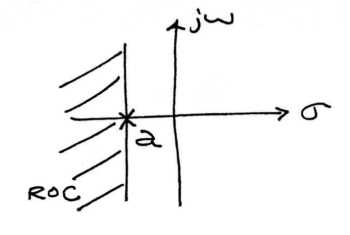| << Chapter < Page | Chapter >> Page > |
With the Laplace transform , the s-plane represents a set of signals ( complex exponentials ). For any given LTI system, some of these signals may cause the output of the system toconverge, while others cause the output to diverge ("blow up"). The set of signals that cause the system's output to convergelie in the region of convergence (ROC) . This module will discuss how to find this region of convergence forany continuous-time, LTI system.
Recall the definition of the Laplace transform,
Although we will not go through the process again for anticausal signals, we could. In doing so, we would find that thenecessary condition for convergence is when
Perhaps the best way to look at the region of convergence is to view it in the s-plane. What we observe is that for asingle pole, the region of convergence lies to the right of it for causal signals and to the left for anti-causal signals.


Once we have recognized this, the natural question becomes: What do we do when we have multiple poles? The simple answeris that we take the intersection of all of the regions of convergence of the respective poles.
Find and state the region of convergence for
Breaking this up into its two terms, we get transfer functions and respective regions of convergence of


Notification Switch
Would you like to follow the 'Signals and systems' conversation and receive update notifications?